Moving Faster Toward New School Models

The most important K-12 innovation of the last twenty years has been new school development. The most important development of the last five years has been new tools. The most important innovations in learning today are where smart teams and developing new tools and schools simultaneously. Summit Public Schools, in the Bay Area and Puget Sound regions, are the best example of this innovative and iterative approach.
A new report from NewSchools Venture Fund outlines the path toward more innovative new school models. The report outlines the opportunity set:
American young people deserve a better model of schooling. Creating it requires us to rethink the way we design and operate schools. We cannot simply change one piece, such as standards or curriculum, or to add on a few new programs. Such “point solutions” can make an important difference, but usually in narrow or isolated ways. They do not add up to radically different outcomes for all students, because for any one element to work well, it must work in concert with all of the other pieces.
The report suggests that innovative schools:
- Start with learning goals that are broad, deep, and interdisciplinary across academic, cognitive and social-emotional aims; and, hold the highest of expectations for all students to meet these ambitious goals
- Give students the freedom and power to own their learning, choosing the pace and types of learning activities that work best for them, in service of their goals.
- Personalize the learning experience to meet every student based on where she is, what she needs, and her goals and strengths.
- Equip parents to be active partners with the school and with their children.
- Foster a community of togetherness, with diverse groups of students, educators, and parents constantly sharing and working together.
This isn’t just about EdTech. The report argues for deep family and student engagement, reimaging educator roles, rethinking time and and space as well as leveraging technology.
Reformer and foundations have probably opened almost 10,000 new schools in the last 15 years but that still leaves 90% of kids in the time and tradition bound schools. How will innovation scale? The authors suggest a four part theory of change:
- Innovators. IF visionary teams of educators and communities have sufficient time, design talent, and money to innovate and iterate, THEN they will build breakthrough models that transcend the limits of today’s paradigm. (The NGLC Regional Funds for Breakthrough Schools models and illustrates how partners can come together in hubs to create change).
- Early adopters. IF models developed by innovators a) create dramatically better outcomes on a broad definition of student success, and b) are designed to be easy for others to implement, THEN early adopters, with modest design, implementation, and financial support will take up these models – in part or in whole – in their own districts and school networks. The set of early adopters is also a breeding ground for new innovators, who want to push the bounds beyond what currently exists.
- Community demand. IF those models resonate with what parents want for their children and prove results and students and families have meaningful exposure to them, THEN they will demand the experiences provided by these new models of schooling (including the requisite policy conditions) resulting in stronger outcomes for all students on an expanded definition of success.
- Favorable policy conditions. IF the policy context is conducive to the features of the new models (e.g., competency-based approaches to credit, accountability system based on individual growth in academic knowledge and skills rather than absolute proficiency, as well as an emphasis on additional dimensions of student success such as collaboration, communication, agency, self-management, etc.), THEN more and more districts/schools will have the ability to adopt new models in response to increasing demand from families and communities, and more innovation will emerge.
- Virtuous cycle. IF all of the above happen in continuous, mutually reinforcing cycles, THEN over the next 3-5 years, we will unleash unprecedented progress in driving and spreading breakthrough school models. Embracing continuous learning through rapid iteration, refining and redesigning as we learn more and more.
This theory of change depends on concentrated R&D funding, “evidence suggests that fundamental, breakthrough redesign could require at least $5 million of R&D funding per model spread over four or five years.”
Change requires talent and teams with the, “capacity to develop, build, assess, refine, and codify whole school models.” This requires drafting experts as well as implementers, and deep community engagement.
The change will also require states and communities to embrace broader aims, “to know whether innovative schools are succeeding along broader dimensions such as student agency, social-emotional learning, and executive function, we need valid, reliable, and agreed-upon measures.”
The report calls for educators to learn about new school models and to look for room to innovate. Parents should encourage schools to develop an aspirational vision for learning and success. (Reading Smart Parents: Parenting for Powerful Learning is a good place to start.)
The report urges funders to take some risk, build an innovation portfolio, and have some patience. One of the best examples of Next Generation Learning At Scale are the regional NGLC funds.
For more on NewSchools, see:
- NewSchools Ignite: Funding Entrepreneurs and Filling EdTech Gaps
- NewSchools Catapult’s Invent 2015: Broader Aims, LX Focus, Strategies & Impact
- NewSchools is Sponsoring Innovative New Schools
For more on next-gen schools and school designs,





0 Comments
Leave a Comment
Your email address will not be published. All fields are required.